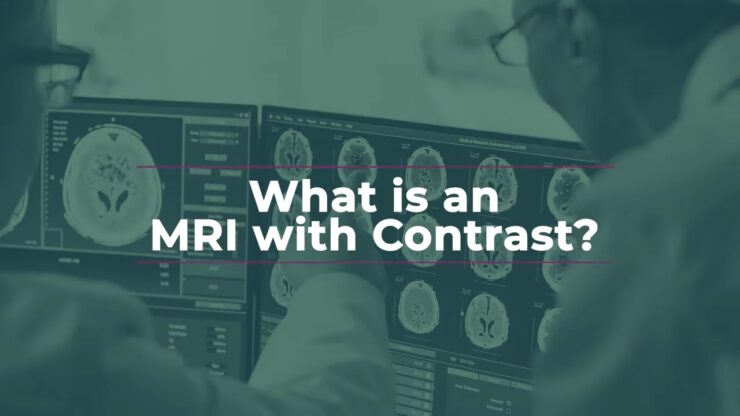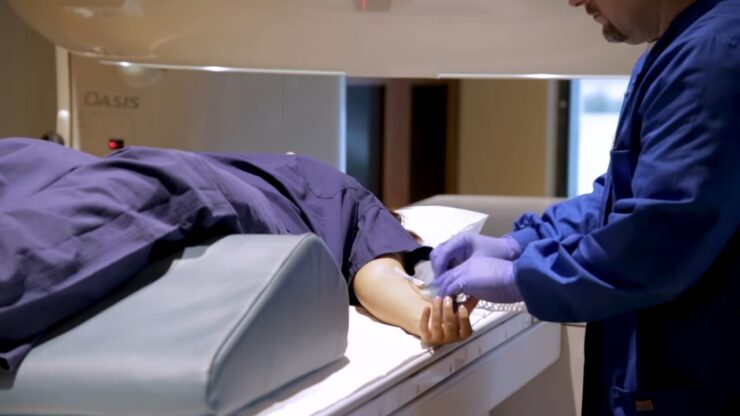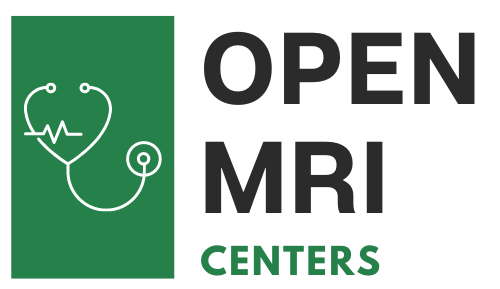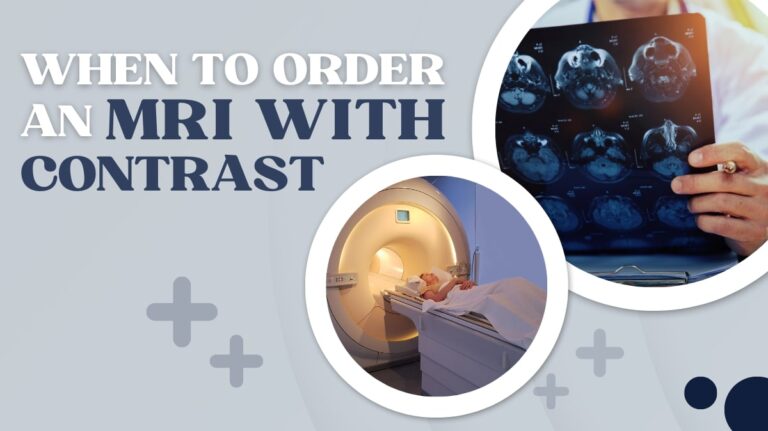Magnetic Resonance Imaging (MRI) is a medical imaging technique that uses powerful magnets and radio waves to create detailed images of the body’s internal structures. MRI with contrast, which involves injecting a contrast dye into the body, can provide even more detailed images and can be useful in diagnosing certain medical conditions.
However, it’s important to know when it’s appropriate to order an MRI with contrast. In this article, we’ll explore the situations in which an MRI with contrast may be recommended and the potential risks and benefits of this procedure.
Understanding MRI with contrast
MRI with contrast? It’s an imaging test! Magnetic fields and radio waves make detailed pictures of the inside of your body. Used to diagnose and watch medical conditions.
When to get one? Let’s explore the basics and when an MRI with contrast might be needed.
What is contrast?
It is a material used during an MRI. It provides a sharp, detailed picture of your body’s inner structures. With it, a special substance is injected. This makes certain parts of the body show up better on the MRI scan.
Some things to keep in mind about when to get an MRI with contrast:
- To better view tumors, infections, and other irregularities, this kind of MRI is often ordered.
- If the doctor suspects something in the brain, chest, or abdomen, they may ask for a contrast MRI.
- If you have a kidney issue, it could be risky, so it’s best not to get one.
These scans can help doctors make correct diagnoses and create effective treatment plans.
Why is contrast used in MRIs?
MRI with contrast is employed to create a clearer, more detailed image of the body’s inner structures. These agents are substances injected into the bloodstream to make certain tissues or organs more visible during an MRI scan.
It is applied for several motives, such as:
- Improving visualization of small, hard-to-see structures;
- Differentiating between tissue characteristics, like inflammation, scarring or tumors;
- Making blood vessels and blood flow more visible;
- Helping to detect and diagnose particular medical conditions earlier.
Typically, it is ordered when a patient has a suspected tumor or infection, or when there is a demand for more detailed imaging of certain organs or tissues. But, if it should be employed or not, depends on the person’s medical history, current symptoms, and general health. Your doctor will decide whether or not an MRI with contrast is necessary based on your medical situation.
How is contrast injected during an MRI?
MRI scans employ a contrast agent injected into the patient’s body to make certain tissues and blood vessels visible during imaging. Here’s how it is administered:
- The patient is positioned on a table that slides into the MRI machine.
- It is injected into a vein of the arm using an IV line.
- It circulates through the body, absorbed by various tissues and blood vessels.
- The MRI machine utilizes radio waves and a strong magnetic field to create detailed images of the targeted areas.
- If a contrast-enhanced MRI is needed, your doctor will order it based on your medical history and symptoms.
Imaging Abnormalities
Magnetic Resonance Imaging (MRI) with contrast is a tool to spot changes in your body. It can pinpoint abnormalities in an organ, tissue, or bone.
When you might need it? This section will explain the imaging abnormalities that may necessitate it.
Identifying growths or tumors
It’s essential to detect growths or tumors in the body. In certain cases, it is needed to find abnormal growths not visible on normal scans. Here are some instances when MRI with contrast is necessary:
- Brain or spinal tumor or abnormality?
- Breast cancer diagnosis, including planning and treatment?
- Pinpointing liver tumors?
- Investigating kidney or adrenal gland tumors?
- Diagnosing lung cancer?
- Diagnosing bone cancer or other bone oddities?
It’s key to consult with your doc, learn the risks and benefits of the tests, and follow preparation instructions so results are accurate.
Differentiating between benign growth and malignant growth
Imaging abnormalities can be either benign or malignant. Knowing the difference is essential to make the right diagnosis, treatment, and follow-up plan.
Benign growths are harmless and don’t cause cancer. They grow slowly, keep their shape and size, and don’t spread to other tissues.
Malignant growths are cancerous and life-threatening if untreated. They grow fast, have an irregular shape, and spread to other organs.
It can help tell the difference. Benign tumors have slow, steady contrast enhancement. Malignant tumors have rapid and irregular enhancement. Discuss the results with your doctor to decide the best course.
Finding inflammation or infection
A doctor may recommend an MRI with it to identify imaging abnormalities when looking for signs of inflammation or infection. This special dye injected into the bloodstream highlights certain areas of the body. So, a more accurate view of the affected area is seen, helping to diagnose conditions e.g. infections, inflammation, and tumors.
If you experience symptoms such as pain, swelling, or redness, your doctor may suggest an MRI with contrast. It can detect soft tissue changes that other imaging tests may miss.
But, keep in mind that they may have risks and side effects. So, only do it when necessary and appropriate. Talk to your doctor about any concerns before undergoing the test.
Indications for Ordering an MRI with Contrast

An MRI with contrast is a helpful resource for medical specialists. It helps them diagnose issues with the brain, spine, and other organs. It allows them to recognize between healthy and unhealthy tissue, detect tumors, and detect signs of infection.
In this piece, we’ll talk about when it’s wise to get an MRI with contrast.
Abnormalities found in non-contrast MRI scans
Sometimes, non-contrast MRI scans don’t show abnormalities. This material can help. So, an MRI with it may be necessary in some cases.
These include:
- Evaluating vascular abnormalities, like aneurysms or blood clots.
- Examining inflammation, such as for meningitis or spinal cord injury.
- Investigating infections, like abscesses.
- Checking for tumors, as cancerous tissues tend to absorb contrast material more.
It’s important to note that this material may cause allergic reactions. So, always get a medical history before ordering an MRI with contrast.
Specific clinical disorders
For many medical conditions, having this type of MRI is necessary.
Reasons for ordering this type of MRI include:
- Cancer diagnosis and staging: It can determine if there are tumors, their size, place, and how much they have spread.
- Vascular abnormalities: This exam can detect problems with blood vessels, like aneurysms or blockages.
- Neurological disorders: It can be useful in diagnosing and monitoring conditions, such as multiple sclerosis or brain tumors.
- Infection: This imaging can help detect the site of infection and watch its progress.
- Inflammation: This type of MRI can point out areas of inflammation, like arthritis or Crohn’s disease.
It’s essential to think about the risks and benefits before ordering an MRI with contrast. It should only be done when needed.
Suspected vascular abnormalities
A physician may suggest it for a patient with assumed vascular abnormalities or other medical problems.
When to order an MRI with contrast:
- Suspected vascular abnormalities, e.g. an aneurysm or AVM.
- Suspected tumors or other growths in the brain or other parts of the body.
- Suspected damage or injury to the spinal cord or nerves.
- Suspected inflammation or infection in the brain, spine, or other body parts.
- Suspected issues with blood vessels or blood flow, e.g. stroke or embolism.
It is essential to adhere to your doctor’s instructions and advice for preparing and having an MRI with it.
Contraindications for Ordering an MRI with Contrast
This MRI needs a dye injection for better visualization of the body and organs. But, certain contraindications prevent someone from receiving this injection.
This part will discuss the potential contraindications for ordering an MRI with contrast and why someone shouldn’t get it.
Acute Kidney Injury
Acute Kidney Injury is a condition that needs special attention when considering an MRI with it. Some contraindications must be taken into account before ordering the MRI.
These contraindications include:
- Severely reduced kidney function (GFR below 30 ml/min)
- Contrast allergy history
- Multiple myeloma or other paraproteinemic diseases
- Dehydration
- Severe heart failure or respiratory distress.
In such cases, it is recommended to avoid CT or MRI using contrast as it may worsen the kidney injury. MRI without contrast or other imaging techniques can be used instead.
Allergies

Medical imaging is a must for diagnosing many medical conditions. But, for those with allergies to contrast agents used in MRIs, caution must be taken.
These are 4 contraindications for getting an MRI with contrast:
- Allergic reactions to GBCAs.
- Kidney issues.
- Allergies to injectable contrast material, including iodine-based agents.
- Pregnancy.
If a patient has any of these contraindications, alternative imaging methods without the use of a contrast agent should be considered. To make sure the patient’s health is a top priority, consulting healthcare providers before any medical procedure is key.
Pregnancy
These two don’t mix. It may cause harm to the baby. So, MRI should only be done if the benefits outweigh the risks.
If you must have an MRI, wait until the second or third trimester. Use the lowest dose of it. Monitor the baby’s condition after.
Talk to your doctor. They can help you make an informed decision.
Risks and Side Effects of Contrast Agents
If your healthcare provider requested an MRI with it, it’s important to know about potential risks and side effects. Contrast agents, or ‘contrast dye’, are substances injected or taken orally before the scan.
This section will look closer at the risks and side effects of an MRI with contrast.
What are the risks?
They can be useful in medical imaging. But, patients and healthcare providers must be aware of their potential risks and side effects. Allergic reactions, kidney damage, and injection site reactions are common risks.
Patients with allergies, kidney problems, or thyroid issues may be at greater risk of adverse reactions. So, they must discuss their history with their healthcare provider.
Healthcare providers should consider potential risks and benefits before recommending these agents.
Common side effects
These agents boost medical imaging. But, they have side effects. These may include nausea and vomiting, headaches, itching, swelling, low blood pressure, and anaphylaxis (severe allergic reaction). Usually, these side effects are mild and short-lived.
If you experience any unusual symptoms or discomfort, tell your healthcare provider. Also, let your healthcare provider know if you have allergies or kidney disease. Weigh the benefits of using these agents with the risks. Only get them if truly necessary.
Rare but serious side effects
They are generally safe and used for medical imaging. However, there are serious side effects. These include:
Allergic reactions – from mild to severe. Symptoms like hives, itching, swelling, and difficulty breathing can happen. Also anaphylactic shock.
Nephrogenic systemic fibrosis (NSF) – is a rare condition. It causes fibrosis in major organs – like the heart, lungs, and skin. It’s related to certain contrast agents in people with kidney issues.
Contrast-induced nephropathy (CIN) – kidney damage from contrast agents. It’s more likely in those with pre-existing kidney disease, diabetes, and other risk factors.
To prevent these risks, healthcare providers need to screen patients before and monitor them during and after the MRI with contrast.
FAQs
Is MRI with contrast safe during pregnancy?
It is generally not recommended during pregnancy unless the benefits outweigh the risks.
Is there any preparation required before an MRI with contrast?
Yes, patients may be asked to fast or avoid certain foods and medications before the procedure.
How long does an MRI with contrast take?
It can take anywhere from 30 minutes to over an hour, depending on the area being imaged.
What should I expect during an MRI with contrast?
During it, patients lie on a table that slides into a tunnel-shaped machine. They may be asked to hold their breath or stay still during the imaging.
How long does it take to get the results of an MRI with contrast?
The results of an MRI with it can typically be obtained within a few days.
Does insurance cover the cost of an MRI with contrast?
Insurance coverage for it can vary depending on the specific insurance plan.
Who can order an MRI with contrast?
It is typically ordered by a healthcare provider, such as a doctor or radiologist, who has determined that the procedure is necessary for diagnosis.
Conclusion
In conclusion, MRI with contrast can be a valuable diagnostic tool in certain medical conditions, providing detailed images that can help healthcare providers make accurate diagnoses and treatment plans. However, it’s important to consider the potential risks and benefits of this procedure, including the possibility of adverse reactions to the contrast agent.
Ultimately, the decision to order an MRI with contrast should be based on a thorough evaluation of the patient’s medical history and symptoms, as well as a careful assessment of the risks and benefits. If you have any concerns about MRI with contrast, it’s important to discuss them with your healthcare provider.

